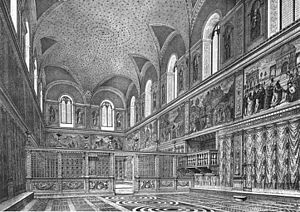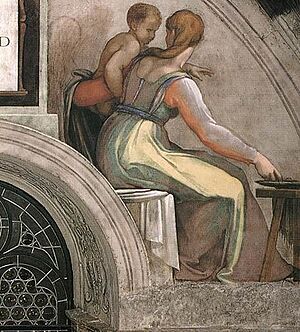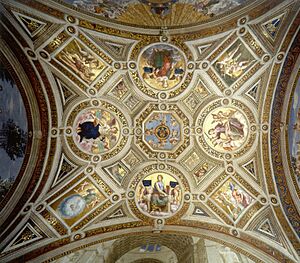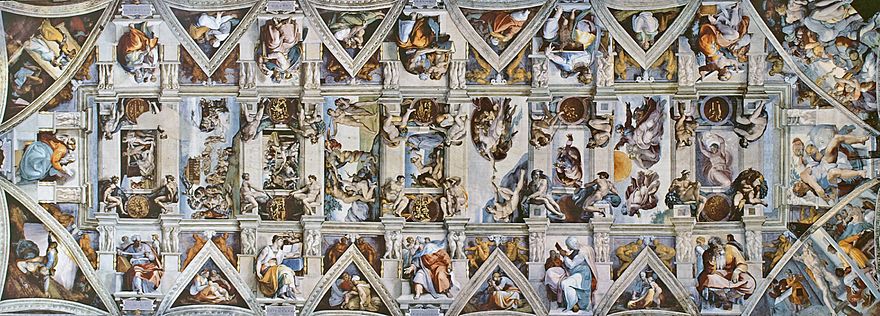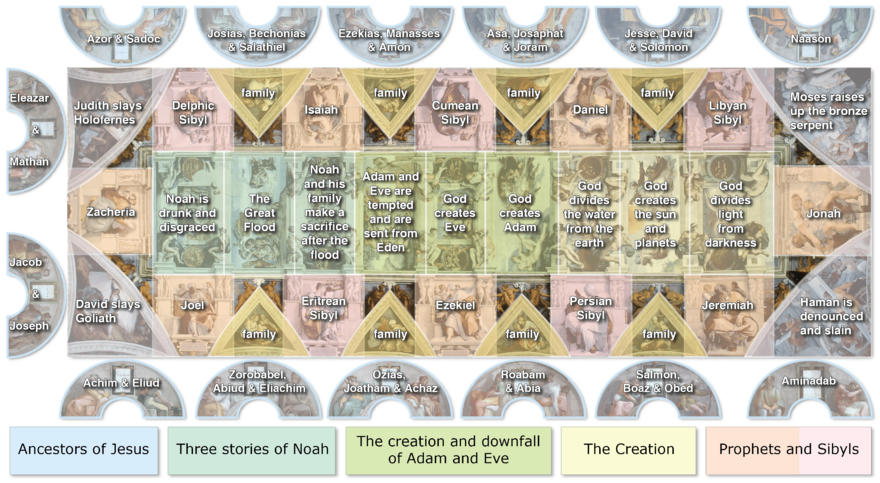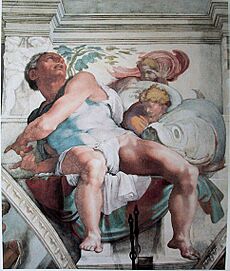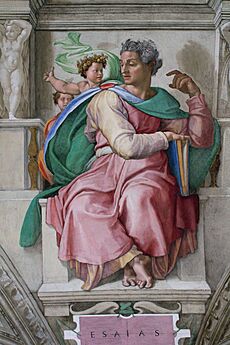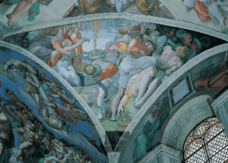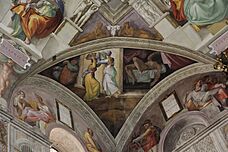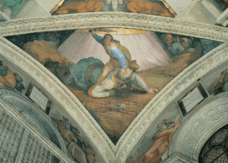Sistine Chapel ceiling facts for kids
The Sistine Chapel ceiling (Soffitto della Cappella Sistina in Italian) is a famous fresco painting by Michelangelo. He painted it between 1508 and 1512. This artwork is a very important part of High Renaissance art.
The Sistine Chapel is a large chapel in Vatican City. It was built by Pope Sixtus IV between 1477 and 1480, and it's named after him. Pope Pope Julius II asked Michelangelo to paint the ceiling.
The ceiling is part of a bigger art project in the chapel. Before Michelangelo, other famous artists like Sandro Botticelli and Pietro Perugino painted the walls. After the ceiling, Raphael designed large tapestries for the lower walls. Michelangelo later returned to paint The Last Judgment behind the altar. The chapel's art shows many ideas of the Catholic Church. It's used for important events like choosing a new Pope.
The main part of the ceiling shows nine scenes from the Book of Genesis in the Bible. This includes The Creation of Adam, which is very famous. The design is complex, showing Michelangelo's amazing skill in painting human figures in many different poses. People loved the ceiling right away, and other artists copied it. It has been cleaned and restored several times, most recently from 1980 to 1994.
Quick facts for kids Sistine Chapel ceiling |
|
|---|---|

The inside of the Sistine Chapel showing the ceiling and other paintings. Michelangelo's The Creation of Adam is near the top.
|
|
| Artist | Michelangelo |
| Location | Sistine Chapel, part of Vatican Museums, Vatican City |
| 41°54′11″N 12°27′16″E / 41.90306°N 12.45444°E | |
| Followed by | The Last Judgment |
Contents
How the Ceiling Was Created
The walls of the Sistine Chapel were painted about 20 years before Michelangelo started on the ceiling. Later, Raphael designed tapestries for the lowest part of the walls. The middle part of the walls has frescoes showing the Life of Christ and the Life of Moses. Famous Renaissance painters like Sandro Botticelli and Pietro Perugino created these. The top part of the walls has windows, and between them are paintings of the first 32 popes.
The original ceiling painting was a blue sky with stars. But in 1504, a crack appeared in the ceiling's vault. So, Pope Julius II had the old painting removed.
Pope Julius II was a strong leader who wanted to make Italy powerful under the Catholic Church. He wanted to rebuild St. Peter's Basilica to show the Pope's power. In 1505, he asked Michelangelo to design his tomb. Michelangelo was already a famous artist, but he and the Pope often argued. Michelangelo even secretly left Rome for a while.
In 1506, Pope Julius II decided to have the Sistine Chapel ceiling painted. The chapel was used for important meetings and Masses, so the Pope wanted the art to have many deep meanings.
The Pope first wanted Michelangelo to paint twelve large figures of the Apostles. But Michelangelo wanted to create a much bigger and more complex design. He was finally allowed, in his own words, "to do as I liked." Many people think Michelangelo himself came up with the whole plan for the ceiling. His biographer, Ascanio Condivi, said Michelangelo read the Old Testament many times for inspiration.
Michelangelo was mostly a sculptor, not a painter. He didn't want the job and suggested his rival, Raphael, do it instead. But the Pope insisted. The contract was signed on May 8, 1508. The Pope's architect, Donato Bramante, built the first scaffolding by hanging ropes from holes in the ceiling. Michelangelo didn't like this because it would leave holes in the painting. So, he built his own freestanding scaffolding.
Michelangelo started painting at the west end of the chapel. He worked backward through the Bible stories. The first half of the ceiling was shown to the public in August 1511. After a break to prepare new scaffolding, the second half was painted quickly. The finished work was revealed on October 31, 1512. Michelangelo's final design has over 300 figures.
People were amazed when they saw the chapel. Michelangelo, at 37, became known as il divino (the divine one). He was seen as the greatest artist of his time, and his reputation lasted his whole life. The ceiling was immediately considered one of the greatest masterpieces ever.
How Michelangelo Painted
Michelangelo likely started planning and sketching in April 1508. The ceiling was prepared by late July. He worked on the main design until August 1510. Then, he stopped for several months because of a disagreement over payments. The Pope finally saw the progress in August 1511. The entire ceiling was shown to visitors on October 31, 1512.
The chapel was still used for religious services during the painting. Work started at the west end, away from the altar, to cause less disruption. There are different ideas about how the ceiling was painted and how the scaffolding was set up.
One main idea is that the frescoes were painted in stages. The scaffolding was moved after each section was done. The first part, including the story of Noah, was finished in September 1509. Then, the figures were made larger as Michelangelo realized how they would look from the ground. The figures in the third part, at the east end, were even bigger. The Creation of Adam was painted in this stage. The areas above the windows were painted last using a smaller scaffold.
Another idea is that the scaffolding covered the entire chapel for years. To remove the old starry ceiling, the whole area needed to be reached. This idea is supported by how many "giornate" (sections painted in one day) were found during the modern restoration. If the ceiling was painted in two stages, the number of "giornate" would be very uneven.
The scaffolding was designed to protect the existing wall frescoes and allow religious services to continue. It also let air and some light from the windows reach the workspace. A false ceiling below the scaffolding protected the chapel. Michelangelo likely needed artificial light, like candlelight, which might have affected the bright colors he used.
The entire ceiling is a fresco. This is an old way of painting murals where paint mixes with wet plaster. Michelangelo learned this method from his teacher, Domenico Ghirlandaio. At first, the plaster was too wet and grew mildew. The Pope sent an architect, Giuliano da Sangallo, who explained how to fix it.
Because it was a fresco, Michelangelo had to lay down new plaster every day for each section, called a giornata. At the start of each day, the edges of the old plaster were scraped away, and a new area was prepared.
Michelangelo started painting at the end of the chapel farthest from the altar. He painted the stories in reverse order. The first scenes, like The Drunkenness of Noah, have smaller figures. This is because Michelangelo misjudged the size of the ceiling at first. After painting The Creation of Eve, he moved the scaffolding. Then he painted The Temptation and Fall and The Creation of Adam. As he continued, his style became bolder. The final scene of God creating was painted in just one day.
The ceiling was shown before it could be finished with extra details like gold. Michelangelo didn't want to rebuild the scaffolding. He also said that "holy men who despised wealth" were painted, so they shouldn't wear gold. Pope Julius II died shortly after the ceiling was finished.
Michelangelo painted standing up, not lying on his back. He wrote a poem about how uncomfortable it was, with a sketch showing him painting with his head tilted back.
What the Ceiling Shows
Michelangelo's frescoes tell the backstory to the 15th-century paintings on the chapel walls. While the main scenes show events from the Book of Genesis, there's a lot of discussion about what all the figures mean. The Sistine Chapel ceiling is a shallow curved ceiling, about 35 meters (118 feet) long and 14 meters (46 feet) wide. The chapel's windows cut into the curve, creating areas called lunettes and spandrels.
Michelangelo claimed he had freedom in his artistic plan. But it's likely that the Pope decided the main subjects and themes, and Michelangelo chose how to present them.
The central part of the ceiling is like a flat field. It's outlined by painted architecture and divided into nine sections. These sections look like open skies and show scenes from the Old Testament.
The stories start at the east end of the chapel, above the altar. The first scene shows The Primal Act of Creation. The last scene, at the west end, shows The Drunkenness of Noah. This scene is above the door used by visitors. The Drunkenness of Noah represents the sinful side of humanity.
Above the painted architecture, at the corners of five smaller central sections, are young male figures called ignudi. Their exact meaning is not fully known. They might represent the idea of perfect human form, untouched by Original Sin.
Below the painted architecture, there's another level of figures. These figures are much larger and seem to press against a painted architectural frame. They look like they are coming out towards you.
The four corners of the chapel's ceiling have triangular areas called doubled spandrels. Michelangelo painted four scenes from the Old Testament here, showing how Israel was saved by heroes like Moses, Esther, David, and Judith. These stories were often seen as hinting at the future Crucifixion of Jesus. The stories of David and Judith were popular in Florence because they showed tyrants being defeated.
Above each window are crescent-shaped areas called lunettes. These show the ancestors of Christ. Above them, in triangular spandrels, are eight more groups of figures, but their exact identities are not known. The design is completed by four large corner pendentives, each showing a dramatic Bible story.
Between the windows are triangular areas where the ceiling curves. In these areas, Michelangelo painted figures of Prophets and Sibyls. These twelve figures, seven Old Testament prophets and five Greek-Roman sibyls, were known for predicting the Messiah or the birth of Jesus. The lunettes above the windows show the "purely human" Ancestors of Christ. These are the lowest and darkest parts of the ceiling.
The Ceiling's Design
The Sistine Chapel is about 35 meters (118 feet) long and 14 meters (46 feet) wide. The ceiling rises about 20 meters (65 feet) above the floor. The ceiling's design is quite complex.
The chapel walls have three levels, with six windows on each side of the top level. There were also two windows at each end, but these were covered when Michelangelo painted The Last Judgment. Between the windows are large curved areas called pendentives that support the ceiling. Between the pendentives are triangular arches or spandrels above each window. Above the pendentives, the ceiling is mostly flat.
Michelangelo's painted architecture highlights the real parts of the chapel. He painted decorative lines that look like carved stone. These have two repeated designs: the acorn and the scallop shell. The acorn was a symbol of Pope Sixtus IV and Pope Julius II. The scallop shell is a symbol of the Madonna.
Many small figures are part of the painted architecture. These include columns with baby-like figures holding them up, ram skulls, and bronze figures hiding in shadows. More small figures, both clothed and unclothed, hold up the nameplates of the Prophets and Sibyls. Above the main painted architecture, there are round shields called medallions. These are framed by 20 more figures, the ignudi, who sit on painted platforms. The ignudi seem to be in a space between the painted stories and the chapel itself.
What Stories Are Painted?
Pope Julius wanted the ceiling to follow a specific plan. Michelangelo was given a design that included the Twelve Apostles over the windows. Other ceilings commissioned by Julius also had geometric designs.
Michelangelo worked on drawings for the Pope's plan. But he decided it didn't allow for enough human figures, which he loved to paint. So, the Pope let Michelangelo change the design. Michelangelo probably worked with religious experts to plan the ceiling's themes.
Nine Scenes from Genesis
In the center of the ceiling, Michelangelo painted nine scenes from the Book of Genesis. These are grouped into three sets of three related scenes. The scenes switch between smaller and larger pictures. The smaller ones are framed by two ignudi figures and a medallion.
The first group shows God creating the Heavens and the Earth. The second group shows God creating Adam and Eve, and their disobedience. The third group shows the story of Noah.
The pictures in each group are connected. The nine scenes are meant to be viewed facing the altar. They tell the story chronologically towards the chapel entrance, except for a few that are swapped. This reversed order might symbolize returning to a state of grace.
The scenes, from the altar towards the main door, are:
- The Separation of Light from Darkness
- The Creation of the Sun, Moon and Plants
- The Separation of Land and Water
- The Creation of Adam
- The Creation of Eve
- The Fall and Expulsion
- The Sacrifice of Noah
- The Great Flood
- The Drunkenness of Noah
Creation
The three creation pictures show scenes from the first chapter of Genesis. This chapter says God created the Earth in six days and rested on the seventh. In the first scene, God creates light and separates it from darkness. The next scene, chronologically, is in the third panel. Here, God divides the waters from the heavens. In the central scene, the largest of the three, God is shown twice. On the third day, God creates the Earth and plants. On the fourth day, God puts the Sun and Moon in place to control day and night.
These three scenes are the most dynamic and broadly painted. The first scene shows God dividing light from darkness, appearing in all His power.
Adam and Eve
For the middle part of the ceiling, Michelangelo chose four events from the story of Adam and Eve in Genesis. In this group of three paintings, two are large and one is small.
In the first picture, one of the most famous images in art history, Michelangelo shows God reaching out to touch Adam. Adam looks like he was just created by God. From under God's arm, Eve looks out nervously. Adam reaches out to the creator, who brings future generations with him.
The central scene shows God creating Eve from the side of a sleeping Adam. Michelangelo copied the idea for this from another creation scene by Jacopo della Quercia in Bologna, which he had studied.
In the last painting of this group, Michelangelo combines two scenes. Adam and Eve are taking fruit from the forbidden tree. Eve takes it from the Serpent, and Adam eagerly picks it. Then, they are banished from the Garden of Eden to a world where they must work and experience death.
Noah
Like the first group, the three paintings about Noah are about themes, not strict order. The first scene shows a sheep being sacrificed. This is likely the sacrifice Noah's family made after surviving the Great Flood.
The central, larger scene shows the Great Flood. The Ark floats in the back, while other people try to find safety. A lightning bolt once showed God's anger, but it was damaged in 1797.
The final scene is the story of Noah's drunkenness.
Since Michelangelo painted the Bible scenes in reverse order, some people start looking at the frescoes with The Drunkenness of Noah.
Medallions
Next to the smaller Bible scenes, there are ten medallions. Four of the most detailed ones are full of figures in strong action. The subjects are a bit unclear, but they are thought to be from the Books of Kings in the Bible. They might show:
- Abraham about to sacrifice his son Isaac
- The destruction of the statue of Baal
- Worshippers of Baal being killed
- Uriah being beaten to death
- Nathan the priest telling King David he committed murder
- King David's son Absalom caught in a tree and killed
- Joab secretly killing Abner
- Joram being thrown from a chariot
- Elijah being taken to Heaven
- A scene that was either erased or left unfinished
Twelve Prophetic Figures
On the curved areas along the sides and ends of the ceiling, Michelangelo painted the largest figures: twelve people who predicted a Messiah. These are seven male prophets from Israel and five Sibyls, who were prophetesses from ancient Greek and Roman stories. Jonah is above the altar, and Zechariah is at the opposite end. The other five Prophets and Sibyls are on each long side, with their names on painted marble tablets.
- Jonah (IONAS) – above the altar
- Jeremiah (HIEREMIAS)
- Persian Sibyl (PERSICHA)
- Ezekiel (EZECHIEL)
- Erythraean Sibyl (ERITHRAEA)
- Joel (IOEL)
- Zechariah (ZACHERIAS) – above the main door
- Delphic Sibyl (DELPHICA)
- Isaiah (ESAIAS)
- Cumaean Sibyl (CVMAEA)
- Daniel (DANIEL)
- Libyan Sibyl (LIBICA)
Prophets
Seven prophets from Israel are shown on the ceiling. These include the four major prophets: Isaiah, Jeremiah, Ezekiel, and Daniel. Three minor prophets are also there: Joel, Zechariah, and Jonah.
The Book of Joel predicts Judah's victory over its enemies. Zechariah was the first Prophet painted.
People praise Jonah for its perspective. Of Isaiah, it's said that anyone who studies it will see details from nature itself.
Sibyls
The Sibyls were women in ancient times who could predict the future. They lived at shrines or temples in the Greek and Roman world. They were like Christian prophets because they spoke messages from the gods. They were seen as mouthpieces for divine messages. Their prophecies came before Christian prophets.
Writers from ancient times used the Greek-Roman Sibyls to help explain Christianity. The Pope's court saw ancient times as preparing the way for Christianity. For example, a Christian writer named Lactantius said that a Sibyl once said, "I am the only god and there is no other." This helped show that one God was believed in even before Christianity. Also, the Cumaean Sibyl was quoted by the Roman poet Virgil. Many people in the Renaissance thought this predicted the birth of Jesus.
The Sibyls also appeared in Christian hymns in the Middle Ages. This shows how they were connected to Christian beliefs. There was growing interest in ancient Rome's pagan past within the Catholic Church. So, it's not surprising to see five pagan prophetesses in the Sistine Chapel. Michelangelo's teacher, Domenico Ghirlandaio, had also painted Sibyls on a church ceiling about 20 years earlier.
It's not known why Michelangelo chose these five specific Sibyls out of ten possibilities. Some suggest they were chosen to represent different parts of the world, like Africa, Asia, and Greece.
The Erythraean Sibyl is described as "extraordinarily beautiful" because of her face, hair, clothes, and arms.
Pendentives
In each corner of the chapel, there's a triangular area called a pendentive. On these curved shapes, Michelangelo painted four scenes from Bible stories. These stories are about the salvation of Israel by four heroes: Moses, Esther, David, and Judith. The first two stories were seen as hinting at the future Crucifixion of Jesus. The stories of David and Judith were often linked in Renaissance art, especially by Florentine artists, because they showed how tyrants could be overthrown.
- The Punishment of Haman – to the left when facing the altar
- The Brazen Serpent – to the right when facing the altar
- Judith and Holofernes – to the left when facing the back
- David and Goliath – to the right when facing the back
In the Book of Esther, Haman plans to have all Jewish people killed. The king finds out, and Esther reveals Haman's plot. The king orders Haman to be executed on a scaffold he built himself. Michelangelo shows Haman crucified, with Esther watching and the king giving orders.
In the story of the Brazen Serpent, the people of Israel complain to God and are punished with poisonous snakes. God tells Moses to make a brass snake and put it on a pole. Looking at it miraculously heals people. This painting is full of figures struggling or turning to the snake for healing.
Judith and Holofernes shows the story from the Book of Judith. The painting is split vertically.
In David and Goliath, the shepherd boy David has knocked down the giant Goliath with his sling. Goliath is still alive and trying to get up as David cuts off his head. This is a simpler painting, with David and Goliath in the center.
Ancestors of Christ
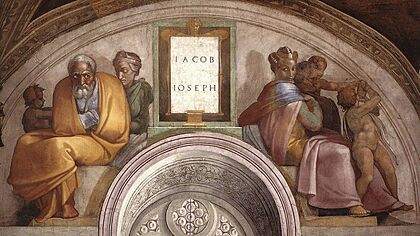
Each side of the chapel has six windows, plus two closed windows at the back and two above the altar that were covered by The Last Judgment. Above each window is an arched shape called a lunette. Above eight of these lunettes are triangular spandrels.
These areas connect the walls and the ceiling. The figures painted on them are about 2 meters (6.5 feet) tall, between the large prophets on the ceiling and the smaller papal portraits on the walls. Michelangelo chose the ancestors of Christ for these images. This connects Jesus' family line to the popes, who are seen as his spiritual successors.
Above each window is a painted marble tablet with names. These are the names of the male line from which Jesus, through Joseph, is descended from Abraham, according to the Gospel of Matthew. However, the list is now incomplete because Michelangelo destroyed two lunettes when he painted The Last Judgment.
The figures in the lunettes look like families, but they often seem divided. They are separated by the name tablet and also by emotions like jealousy, suspicion, anger, or boredom. Michelangelo showed the unhappiness of the human condition in these paintings. The figures "sit, squat and wait" in their tight spaces. The first two lunettes painted are the most detailed. They become less detailed towards the altar end, as Michelangelo painted faster.
Because of the triangular shape, the figures in each spandrel are seated on the ground. Six of them show groups of figures, mostly adults with a child. One shows a woman sewing while her child watches. This might be Hannah, the mother of Samuel.
During the restoration, the figure of Amminadab was found to be wearing a Jewish badge. This was a badge Jews had to wear at the time. This might link this figure from the past to the present, showing Amminadab as exiled from salvation.
Before restoration, the lunettes and spandrels were the dirtiest paintings in the chapel. It was also hard to see them well during the day because of bright areas blurring over darker ones.
Ignudi
The ignudi are 20 athletic male figures that Michelangelo painted. They are supporting figures at each corner of the five smaller creation scenes on the ceiling. Each pair of ignudi frames a medallion. These figures hold ribbons, pillows, and garlands of acorns in many different poses. They are mostly decorative, but they gave Michelangelo a great chance to show his skill. Other Renaissance artists copied their poses.
Some people think the ignudi could be angels, like cherubs. They might also represent the idea of perfect human form. They connect to ancient Greek and Roman art, showing Pope Julius's hope for a new "golden age" for Italy. They also showed Michelangelo's greatness as an artist.
Damage and Restoration
The ceiling was damaged as early as the mid-1500s. In 1797, a gunpowder explosion damaged part of The Flood painting and one of the ignudi.
Over the centuries, the ceiling became dark from candle smoke and layers of varnish. This made the original colors very dull. Some restorations happened in the early and mid-1900s. After tests in 1979, the ceiling was restored between 1980 and 1992.
The first part of the restoration, on the lunettes, happened from 1980 to 1984. Then, work moved to the ceiling, finishing in 1989. After that, The Last Judgment was restored. The restored ceiling was shown by Pope John Paul II on April 8, 1994.
The restoration removed the dirt and grime, revealing colors much closer to how they looked when first painted. The ceiling now looks like daytime scenes with bright, clear colors. The restoration received both praise and criticism. Some critics said that important original details by Michelangelo were lost when layers were removed.
In 2007, the Vatican worried that the newly restored frescoes might be damaged. They announced plans to reduce visiting hours and raise ticket prices to discourage too many visitors.
See also
- List of works by Michelangelo
- Index of Vatican City–related articles
- The Agony and the Ecstasy


